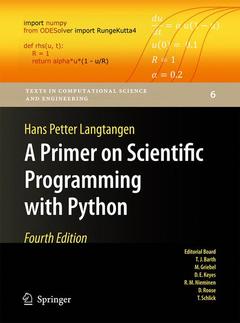Description
A Primer on Scientific Programming with Python (4th Ed.)
Author: LANGTANGEN Hans Petter
Language: English
Subject for A Primer on Scientific Programming with Python:
Approximative price 63.29 €
In Print (Delivery period: 15 days).
Add to cart865 p. · 19.5x26.5 cm · Hardback · Two-tone printing
Description
/li>Contents
/li>Comment
/li>
Example-oriented text with all applications taken from science and engineering
Aimed at newcomers to programming and Python, but proved to be useful for professionals too
All examples are accompanied by complete program codes, which can be modified to the reader's needs
Covers both Matlab-style "simple" programming and object-oriented programming
Demonstrates how Python can be an alternative to Matlab in scientific computing




